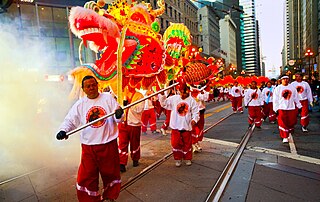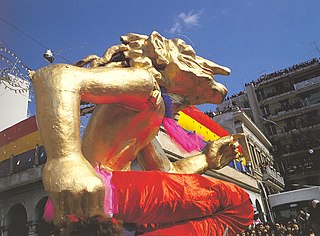
A parade is a procession of people, usually organized along a street, often in costume, and often accompanied by marching bands, floats, or sometimes large balloons. Parades are held for a wide range of reasons, but are usually celebrations of some kind. In British English, the term 'parade' is usually reserved for either military parades or other occasions where participants march in formation; for celebratory occasions, the word procession is more usual. In the Canadian Forces, the term also has several less formal connotations.

Carnival is a Catholic festive season that occurs before the liturgical season of Lent. The main events typically occur during February or early March, during the period historically known as Shrovetide. Carnival typically involves public celebrations, including events such as parades, public street parties and other entertainments, combining some elements of a circus. Elaborate costumes and masks allow people to set aside their everyday individuality and experience a heightened sense of social unity. Participants often indulge in excessive consumption of alcohol, meat, and other foods that will be forgone during upcoming Lent. Traditionally, butter, milk, and other animal products were not consumed "excessively", rather, their stock was fully consumed as to reduce waste. This festival is known for being a time of great indulgence before Lent, with drinking, overeating, and various other activities of indulgence being performed. For example, Pancakes, donuts, and other desserts are prepared and eaten for a final time. During Lent, animal products are eaten less, and individuals have the ability to make a Lenten sacrifice, thus giving up a certain object or activity of desire.
Midsummer is the period of time in the middle of the summer. The exact dates vary among different cultures, but is primarily held close to the summer solstice. It has often been claimed that the Church authorities wanted to "Christianize" the pagan solstice celebrations and for this reason advanced the Nativity of John the Baptist as a substitute for a formerly pagan festival.

A comparsa is a group of singers, musicians and dancers that take part in carnivals and other festivities in Spain and Latin America. Its precise meaning depends on the specific regional celebration. The most famous comparsas are those that participate in the Carnival of Santiago de Cuba and Carnaval de Barranquilla in Colombia. In Brazil, comparsas are called carnival blocks, as those seen in the Carnival of Rio de Janeiro and other Brazilian carnivals. In the US, especially at the New Orleans Mardi Gras, comparsas are called krewes, which include floats.

The Main Street Electrical Parade is a nighttime parade, created by Robert Jani and project director Ron Miziker. It features floats and live performers covered in over 600,000 electronically controlled LED lights, and uses a synchronized soundtrack triggered by radio control along key areas of the parade route.

The Carnival of Brazil is an annual Brazilian festival held the Friday afternoon before Ash Wednesday at noon, which marks the beginning of Lent, the forty-day period before Easter. During Lent, Roman Catholics and some other Christians traditionally abstained from the consumption of meat and poultry, hence the term "carnival", from carnelevare, "to remove meat."

The Carnival of Barranquilla is one of Colombia's most important folkloric celebrations, and one of the biggest carnivals in the world. The carnival has traditions that date back to the 19th century. Four days before Holy Week, Barranquilla decks itself out to receive national and foreign tourists to join together with the city's inhabitants to enjoy four days of intense festivities. During the carnival, Barranquilla's normal activities are put aside as the city gets busy with street dances, musical and masquerade parades. The Carnival Of Barranquilla includes dances such as the Spanish paloteo, African Congo, and indigenous mico y micas. Many styles of Colombian music are also performed, most prominently cumbia, and instruments include drums and wind ensembles. The Carnival of Barranquilla was proclaimed a Cultural Masterpiece of the Nation by Colombia's National Congress in 2002. Also the UNESCO, in Paris on November 7, 2003, declared it one of the Masterpieces of the Oral and Intangible Heritage of Humanity, and it was during Olga Lucia Rodriquez Carnival Queen year.

The Solstice Cyclists is an artistic, non-political, clothing-optional bike ride celebrating the Summer Solstice. It is the unofficial start of the Summer Solstice Parade & Pageant, an event produced by the Fremont Arts Council in the Fremont district of Seattle.

The Fremont Solstice Parade is an annual event that occurs each June in Seattle, Washington.

The Carnival in Rio de Janeiro is a festival held every year before Lent; it is considered the biggest carnival in the world, with two million people per day on the streets. The first Carnival festival in Rio occurred in 1723.
There have been seven theme park live adaptations of The Lion King at Disney parks since the animated film The Lion King was released by Walt Disney Animation Studios in 1994. These have included a parade, two theater-in-the-round shows, and four stage shows.

The San Francisco Chinese New Year Festival and Parade is an annual event in San Francisco. Held for approximately two weeks following the first day of the Chinese New Year, it combines elements of the Chinese Lantern Festival with a typical American parade. First held in 1851, along what are today Grant Avenue and Kearny Street, it is the oldest and one of the largest events of its kind outside of Asia, and one of the largest Asian cultural events in North America. The parade route begins on Market Street and terminates in Chinatown.

The Patras Carnival, Patrino karnavali is the largest event of its kind in Greece. It has more than 180 years of history. The events begin on 17 January and last up to Clean Monday. The carnival of Patras is not a single event but a variety of events that includes balls, parades, hidden treasure hunt and the children's carnival amongst others. It climaxes in the last weekend of Carnival with the Saturday evening parade of carnival groups, the extravagant Sunday parade of floats and groups, and finally the ritual burning of the carnival king at the St. Nikolaos Street pier in the harbour of Patras. Its characteristics are spontaneity, improvisation, inspiration and volunteerism. In 2019, there were about 750.000 participants in the carnival
Carnaval San Francisco, established 1979, is an annual street parade and festival in San Francisco, California, United States, held on the last weekend in May.

The Carnival of Santa Cruz de Tenerife is held each February in Santa Cruz de Tenerife, the capital of the largest island of the Canary Islands, Spain and attracts people from all over the world.

Lucidity is an annual, three-day transformational festival in Santa Barbara, California.
Carifiesta is an annual Caribbean Carnival held in Montreal, Quebec, Canada. It was established in 1974, and is held in July. The event is coordinated by the Caribbean Cultural Festivities Association, a nonprofit organization. Carifiesta was established prior to some Carnivals that take place in the Caribbean, for example, Cayman Carnival Batabano. Carifiesta has also been named the largest North-American running Caribbean Street Parade.
Numerous events and festivals are held annually in Metro Manila. They include:
Carnival in Mexico is celebrated by about 225 communities in various ways, with the largest and best known modern celebrations occurring in Mazatlán and the city of Veracruz.

Paint the Night Parade was a nighttime parade, which was formerly at Hong Kong Disneyland, Disney California Adventure, and Disneyland. The Hong Kong version premiered on September 11, 2014, as part of the park 9th anniversary expansion. The Disneyland version debuted on May 22, 2015, as part of the park's 60th anniversary Diamond Celebration. The parade is a spiritual successor to the long-running Main Street Electrical Parade, which has appeared at numerous Disney parks in several different incarnations since June 17, 1972. At Disneyland Park in California, Paint the Night made its last regular performance on September 5, 2016, and returned as a seasonal offering for the 2016 holiday season. The original Main Street Electrical Parade returned to Disneyland Park on January 19, 2017 for a limited-time run.













